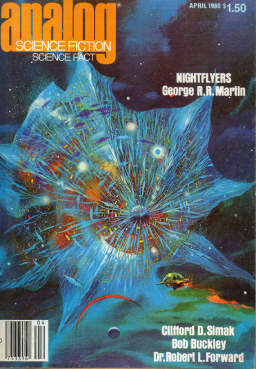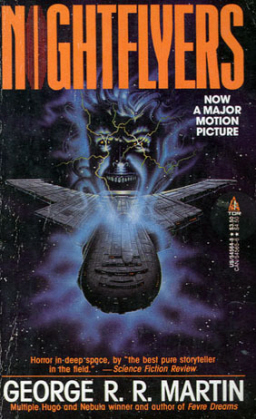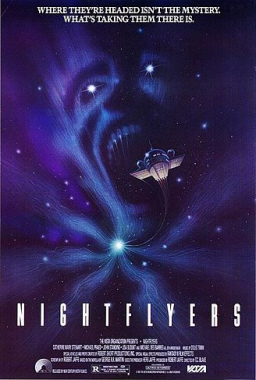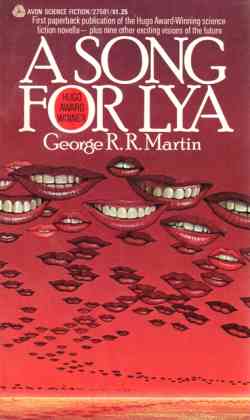Vintage Treasures: George R.R. Martin’s “Nightflyers”
 Over the weekend I put away a collection of 80s magazines I purchased a few months ago. In the process I discovered the April 1980 issue of Analog, which I read as a junior in high school in Ottawa, Canada.
Over the weekend I put away a collection of 80s magazines I purchased a few months ago. In the process I discovered the April 1980 issue of Analog, which I read as a junior in high school in Ottawa, Canada.
There’s a lot to like about this issue, from the gorgeous cover by Paul Lehr — perhaps my favorite SF artist — to a famous short story by one of my all-time favorite SF writers: “Grotto of the Dancing Deer,” by Clifford D. Simak, which won both the 1980 Nebula Award and 1981 Hugo Award for Best Short Story. Even the ads reflect those things I personally found most exciting and fresh about SF and fantasy at the time: a full page ad from TSR for D&D, “The Ultimate in Adventure Games;” an ad for six microgames from Metagaming (the company that introduced me to role playing games), including the classic Ogre; and a subscription form for Ares, the short-lived SF gaming magazine from SPI.
This issue is an intriguing cultural artifact for other reasons. There’s an editorial from Stanley Schmidt in response to the recent kidnapping of 50 Americans at the US embassy in Iran, both a fascinating snapshot of a critical moment in American history, and a typical science fiction response:
What the Iranian crisis really demonstrates, at least as dramatically as any incident so far, is that if we want real freedom, we must produce our own energy… Technologies which can do this are possible, and we should not willingly settle for less. Readers of this magazine are well acquainted with the role space can play, but many people are not — and we need to get the action under way now.
If you read Analog in the 20th Century, you got used to this. Exploring space was pretty much the answer to everything — the energy crisis, the hole in the ozone, foreign policy crises, and crappy network television programming — and the magazine’s self-congratulatory tone clearly told its readership (including 15-year-old readers in Ottawa) that they were smarter and more informed than everyone else, especially on science and technology, topics far more important than cars, sports, and other things kids our age obsessed about. Analog told its readers they were destined for success. The future was ours.
But the real reason this issue is remembered is its cover story, George R.R. Martin’s novella of horror in deep space, the chilling classic “Nightflyers.”
[Click on any of the images for larger versions.]
I re-read the story yesterday, and it was just as powerful as I remember it. It opens with an unnamed narrator describing an ancient and mysterious race of aliens, the volcryn, who have been traveling at sublight speeds right through the very heart of interstellar civilization for thousands of years, all unknown to other races:
When Jesus of Nazareth hung dying on his cross, the volcryn passed within a light-year of his agony, headed outward. When the Fire Wars raged on Earth, the volcryn sailed near Old Poseidon, where the seas were still unnamed and unfinished. By the time the stardrive had transformed the Federated Nations of Earth into the Federal Empire, the volcryn had moved into the fringes of Hrangan space…
When I was a child of three… the volcryn passed close to Daronne. That season all the Crey sensitives grew strange and sat staring at the stars with luminous, flickering eyes.
 A single man, Karoly d’Branin, pieces together myths and legends from a handful of alien civilizations and puts together a poorly-funded research organization to find and intercept the volcryn for the first time.
A single man, Karoly d’Branin, pieces together myths and legends from a handful of alien civilizations and puts together a poorly-funded research organization to find and intercept the volcryn for the first time.
Lack of funds forces him to select an unusual ship-for-hire: the Nightflyer, crewed by a single man, Royd Eris. Royd remains unseen, hidden behind sealed bulkheads for the entire trip, communicating with the rest of the crew only through the telecom, and a hologram which looks strangely out-of-date.
But is Royd even human? As the weeks pass and odd things begin to occur on board, the crew begins to speculate that Royd is an artificial intelligence, or a previously unencountered alien… or something even stranger.
Martin builds the tension effectively during the tale. As they edge closer and closer to the mystery of the volcryn in the depths of interstellar space, the situation on the Nightflyer begins to rapidly deteriorate. Strange deaths and unexplained accidents plague the crew. The team’s sole telepath senses a sinister and inhuman presence on board, one that means to kill them.
Some mysteries are revealed, leading to much deeper ones.
I won’t reveal the ending, but it’s a unique and satisfying close involving a life-or-death repair to the ship, undead creatures, the truth about Royd and the inhuman presence on board… and the powerful volcryn, drawing nearer and nearer.
It’s not a perfect story. Martin telegraphs pretty early which characters are worth our sympathies, and which will die an ignominious death, by not bothering to give names to most of the characters. Other than Royd and Karoly, only one other character is blessed with a name, the “improved model” human Melantha Jhirl.
For a 50-page novella, it’s a little weird to have most of the characters referred to only by their profession. Martin doesn’t bother giving the cannon fodder much personality either; the combined effect is almost like a parody of monster movies, where you know instantly which characters are going to buy it by the end of the movie.
 Speaking of movie, Nightflyers was made into a B-movie in 1987, directed by Robert Collector with a script by Robert Jaffe.
Speaking of movie, Nightflyers was made into a B-movie in 1987, directed by Robert Collector with a script by Robert Jaffe.
It wasn’t particularly well-received. Collector was reportedly so unhappy with the final product that he took his name off it, and the Director’s credit went to “T.C. Blake.” It has never been released on DVD, but you can watch the whole thing in 10-minute installments on YouTube.
The story, however, is a different… erm, story. It’s become an acknowledged classic. It was nominated for a 1981 Hugo Award for Best Novella in 1981, and won the 1981 Locus and Analog Lab Awards in the same category. It’s been collected numerous times, including in Martin’s 1985 collection Nightflyers and his more recent Dreamsongs.
True completists will have to track down at least a few of these editions, as the story is quite dramatically expanded in later versions. The Dreamsongs version, for example, is 90 pages (versus 50 for the magazine version), adds several scenes, and it names all the characters.
Here’s a pretty typical paragraph for the 1980 magazine version, for example:
The cyberneticist talked to her computers, and seemed to prefer their company to that of humans.
Here’s the same paragraph in Dreamsongs:
The cyberneticist, Lommie Thorne, talked to her computers, and seemed to prefer their company to that of humans. She was bright and quick, with a mobile, expressive face and a small, hard boyish body; much of the others found her attractive, but she did not like to be touched. She sexed only once, with Melantha Jhirl. Lommie Thorne wore shirts of softly-woven metal, and had an implant in her left wrist that let her interface directly with her computers.
It’s not clear to me whether Martin had to cut his novella for the magazine appearance, or he re-wrote it years later. For my part, I prefer the shorter, more fast-paced version I read first in Analog. But the later version does clear up at least one major mystery not explained in the magazine version, dealing with the fate of one of the named characters.
 George R.R. Martin has a well-deserved reputation as a master of science-fiction horror, a reputation that really began with his classic novella “Sandkings.” “Nightflyers” is a big part of that rep.
George R.R. Martin has a well-deserved reputation as a master of science-fiction horror, a reputation that really began with his classic novella “Sandkings.” “Nightflyers” is a big part of that rep.
Today of course he’s most well known for A Game of Thrones, and I probably can’t expect that he’ll return to producing the tight little gems that once made him famous in SF magazines any time soon.
But Martin published no less than seven highly regarded short story collections nearly a decade before he wrote A Game of Thrones, starting with A Song for Lya in 1976 — more than enough to keep me busy. So I really can’t complain.
Here’s the complete list:
- A Song for Lya (1976)
- Songs of Stars and Shadows (1977)
- Sandkings (1981)
- Songs the Dead Men Sing (1983)
- Nightflyers (1985)
- Tuf Voyaging (1987)
- Portraits of His Children (1987)
If you’re a paperback collector, very few of those will pose you a challenge except Songs the Dead Men Sing, which never had a US paperback release. All of the rest can be had for decent prices on both Amazon and eBay.
John,
Though I am on the road and cannot access my collection, my recollection is that this story was part of a collection re-issued several years later “Nightflyers and Other Stories” by Ace. I suspect Martin may have rewritten it at that point. Speciacally recall this collection as it was one of the first trade paperbacks I purchased, a new trend at that time I did not like. Much preferred paying the mass market price though do not think this collection ever had a mass market edition.
Hi Chuck,
Thanks for the comment. And you’re correct — I just checked my copy of the 1985 NIGHTFLYERS trade paperback (from Bluejay Books, not Ace), and at a quick glance it appears identical to the DREAMSONGS version.
The copyright page indicates the story is taken from BINARY STAR #1 (1981), and that a shorter version appeared in Analog. Still not sure if that means the story was cut for Analog or later re-written, though.
> though do not think this collection ever had a mass market edition.
Actually, there were at least two mass market editions of NIGHTFLYERS. The second picture above is from the 1988 Tor paperback, which tied in with the movie release:
http://www.amazon.com/Nightflyers-George-R-Martin/dp/0812545648
There’s also a 1985 Tor mass market with the same cover as the Bluejay edition:
http://www.amazon.com/Nightflyers-George-R-Martin/dp/0312943326/
At least if I buy these, my wife probably won’t complain, since she’s a HUGE Game of Thrones fan, probably even a bigger fan than I am.
I’m also a big Simak fan, by the way. I met him once during my high school years in the early 80s, at a little science fiction book store in Minneapolis.
Do not know if it was his first appearance in Analog, but the first time I remember reading anything by Martin was a fact article in an early 70’s Analog about computer chess. Certainly it was before some of his classics like “With Morning Comes Mistfall” and “A Song for Lya”. I greatly enjoyed his SF (both shorts and novels) and regret that he did not write more.
How much of his short fiction relative to the paperback collections ended up in Dreamsongs?
The first Martin story I ever read (many years ago, before I even knew who he was) was Sandkings in some random 1980’s anthology or other — freaked me the heck out, it did.
> I’m also a big Simak fan, by the way. I met him once during my high school years in the early 80s, at a little science fiction book store in Minneapolis.
awsnyde,
Ah!! I’ve met many of my writing heroes, but I never had the chance to meet Simak. I envy you.
Chuck,
> I greatly enjoyed his SF (both shorts and novels) and regret that he did not write more.
I don’t think Martin has completely given up writing short fiction. He’s still writing novellas in his Hedge Knight series, and the latest appeared in 2010 in the anthology WARRIORS.
He doesn’t write for magazines much anymore, though.
Joe,
> How much of his short fiction relative to the paperback collections ended up in Dreamsongs?
Boy, that’s a complicated question. DREAMSONGS is actually a reprint of a massive 1,200-page retrospective anthology from Subterranean Press called GRRM: A RRetrospective. It collected 34 stories from his seven earlier collections and more recent publications.
It’s a huge book, and it has its own Wikipedia page. Here’s how the book is described:
“The collection features 34 pieces of fiction (including two TV scripts), an introduction by Gardner Dozois, commentary by Martin on each stage of his career, a Martin bibliography, and original art for each story… The Washington Post called Subterranean’s single-author collection “the most ambitious volume ever to come from an American specialty press”.
Here’s the Wikipedia page:
http://en.wikipedia.org/wiki/GRRM:_A_RRetrospective
So to answer your question… quite a bit of it, but not the majority. There are only two Tuf stories, out of the original seven, for example.
[…] June 1984 issue of Isaac Asimov’s Science Fiction Magazine), and then George R.R. Martin’s “Nightflyers” (Analog, April 1980). And my wife wonders why it takes me two hours to put away a dozen […]
[…] my recent reports on Howard Waldrop’s “The Ugly Chickens,” George R.R. Martin’s “Nightflyers,” and […]
[…] Vintage-treasures-george-rr-martins-nightflyers […]
Bit of Trivia:
The Bluejay cover was by James Warhola, but the subsequent reissue (screaming ghost face/spaceship) was not by Warhola, despite erroneously being attributed to him. No one knows the cover artist it seems… Any ideas? P.S. I am happy to say I own that Paul Lehr cover, which hangs on my walls! 🙂 Cheers!
> No one knows the cover artist it seems… Any ideas?
If it’s not Warhola, then I have no idea. Which is unfortunate, since I think it’s a fine piece of work.
> P.S. I am happy to say I own that Paul Lehr cover, which hangs on my walls!
Ahh! I am so jealous. It’s a fabulous piece, by a terrific artist. Kudos on snapping it up!
Reading this the other day I snickered at how Ridley Scott ripped off GRRM’s device of a spaceship controlled by “Mother.” But the film predates publication of the story by a year, so…
Here’s how GRRM explains the discrepancy in printed versions:
“The original version of “Nightflyers,” published in Analog with a nice Paul Lehr cover, weighed in at 23,000 words…but even at that length, I felt it was severely compressed, especially in the handling of its secondary characters. (They did not even have names, only job titles.) When Jim Frenkel of Dell Books offered to buy an expanded version of the novella for his new Binary Star series, an attempt to revive the old Ace Doubles concept, I leapt at the opportunity. It is the Binary Star version you’ll find here.”
Great story. I must watch this crappy film version, which, like Dune, was Alan Smithee-d.
Thanks KLR! I guess the Binary Stars one (and its reprints) is the one to read.
And let me know what you think of the movie! I re-read the Wikipedia entry on it today…. sure sounds like it was a train wreck.